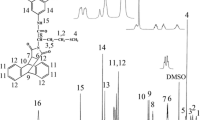Summary
Polypeptides, synthesized from a mixture of amino acid amides by microwave heating during repeated hydration-dehydration cycles, showed hydrolase- and oxidoreductase-like catalytic activities. Poly(GAVDH), polypeptides synthesized from an equimolar mixture (each 0.1 M) of glycinamide,l-alaninamide,l-valinamide,l-aspartic acid α-amide, andl-histidinamide, catalyzed the hydrolysis of PNPAc. The hydrolytic rate of PNPAc with poly(GAVDH) was the quadruple of that ofl-histidine alone. Though the kcat values of different resulting polypeptides were 103–106 times less than those of native hydrolases, the Km value of the polypeptides further containing phenylalanine residues was nearly equal to that of the esterase. This result indicates the presence of hydrophobic interaction between a substrate and the polypeptides. Resulting polypeptides also showed catalytic activity for the reduction of ferricyanide ion [Fe(CN)3−] with NADH. The polypeptides seemed to have a strong affinity for adenine nucleotides, because the reaction was inhibited by adenine derivatives such as NAD+ and AppA. A hypothesis for the emergence of primitive protein enzymes is discussed.
Similar content being viewed by others
Abbreviations
- PNPAc:
-
p-nitrophenyl acetate
- PNPPr:
-
p-nitrophenyl propionate
- PNPBu:
-
p-nitrophenyl butyrate
- HPLC:
-
highperformance liquid chromatography
- TFA:
-
trifluoroacetic acid
- BSA:
-
bovine serum albumin
- Vmax :
-
maximum reaction velocity
- Km :
-
Michaelis constant
- kcat :
-
catalytic rate constant
- V′:
-
hydrolytic velocity per histidine residue contained in polypeptides
- 3-AcPyADH:
-
3-acetylpyridine adenine dinucleotide (reduced form)
- NMNH:
-
β-nicotinamide mononucleotide (reduced form)
- α-NADH:
-
α-nicotinamide adenine dinucleotide (reduced form)
- DCIP:
-
2,6-dichlorophenyl indophenol
- GTP:
-
guanosine 5′-triphosphate
- CTP:
-
cytidine 5′-triphosphate
- AppA:
-
P1, P2-diadenosine 5′-diphosphate
- ΔG′:
-
free energy change
References
Cruickshank P, Sheehan JC (1964) Synthetic peptide model of enzyme active sites. II.L-threonyl-L-seryl-L-histidyl-L-aspartic acid, an active esterase model. J Am Chem Soc 86:2070–2071
Dixon JE, Webb FC (1979) Enzyme inhibition and activation. In: Enzymes, ed 3. Longman, pp 332–467
Dose K, Zaki L (1971) Recent progress in the study and abiotic production of catalytically active polymers of α-amino acids. In: Buvet R, Ponnamperuma C (eds) Chemical evolution and the origin of life. North-Holland, pp 263–276
Fox SW, Harada K (1960) The thermal copolymerization of amino acids common to protein. J Am Chem Soc 82:3745–3751
Fox SW, Krampitz G (1964) Catalytic decomposition of glucose in aqueous solution by thermal proteinoids. Nature (London) 203:1362–1363
Gilbert W (1978) Why genes in pieces? Nature (London) 271:501
Gō M (1983) Modular structural units, exons, and function in chicken lysozyme. Proc Natl Acad Sci USA 80:1964–1968
Gō M, Nosaka M (1987) Protein architecture and origin of introns. Cold Spring Harbor Symp Quant Biol 52:915–924
Katchalski E, Fasman GD, Simon E, Blout ER, Gurd FRN, Koltu WL (1960) Synthetic histidine-containing polypeptides as catalysts for the hydrolysis ofp-nitrophenyl acetate. Arch Biochem Biophys 88:361–365
Kunitake T, Shinkai S (1970) Imidazole catalyses in aqueous systems. IV. Biomolecular and Michaelis-Menten-type catalyses of a phenyl ester hydrolysis by some hydrophobic imidazole derivatives. Bull Chem Soc Jpn 43:2581–2588
Noguchi J, Saito T (1961) Studies on the catalytic activity of synthetic polyamino acids having an imidazole group in the active site. In: Stahmann MA (ed) Polyamino acids, polypeptides and proteins. University of Wisconsin Press, pp 313–328
Oró J (1960) Synthesis of adenine from ammonium cyanide. Biochem Biophys Res Commun 2:407–412
Oró J, Kimball AP (1961) Synthesis of purines under possible primitive earth conditions. I. Adenine from hydrogen cyanide. Arch Biochem Biophys 94:217–227
Oshima T (1968) The catalytic hydrolysis of phosphate ester bonds by thermal polymers of amino acids. Arch Biochem Biophys 126:478–485
Overberger CG, Pierre TSt, Vorhheimer N, Lee J, Vorhheimer S (1965) The enhanced esterolytic catalysis of poly-4(5)-vinylimidazole and poly-5(6)-vinylbenzimidazole. J Am Chem Soc 87:296–301
Overberger CG, Salamone JC, Yaroslavsky S (1967) Cooperative effects in the esterolytic action of synthetic macromolecules containing imidazole and hydroxyl functions. J Am Chem Soc 89:6231–6236
Rohlfing DL (1967) The catalytic decarboxylation of oxaloacetic acid by thermal prepared poly-α-amino acids. Arch Biochem Biophys 118:468–474
Rohlfing DL, Fox SW (1967a) The catalytic activity of thermal polyanhydro-α-amino acids for the hydrolysis ofp-nitrophenyl acetate. Arch Biochem Biophys 118:122–126
Rohlfing DL, Fox SW (1967b) The inactivation of catalytically active thermal polyanhydro-α-amino acids. Arch Biochem Biophys 118:127–132
Schulz GE, Schirmer RH (1979) The structure basis of protein mechanism, action, and function. In: Principles of protein structure. Springer-Verlag, pp 233–251
Sheehan JC, McGregor DN (1962) Synthetic peptide models of enzyme active sites. I.cyclo-Glycyl-L-histidyl-L-serylglycyl-L-histidyl-L-seryl. J Am Chem Soc 84:3000–3005
Sheehan JC, Bennet GB, Schneider JA (1966) Synthetic peptide models of enzyme active sites. III. Stereoselective esterase models. J Am Chem Soc 83:3455–3456
Visser HG, Nolte RJM, Drenth W (1985) Polymers and copolymers of imidazole-containing isocyanides. Esterolytic activity and enantioselectivity. Macromolecules 18:1818–1825
Watson JD, Hopkins NH, Roberts JW, Weiner AM (1987) Evolution of the gene. In: Molecular biology of the gene, ed 4. Benjamin/Cummings, pp 1098–1163
Yanagawa H, Kojima K, Ito M, Handa N (1990) Synthesis of polypeptides by microwave heating I. Formation of polypeptides during repeated hydration-dehydration cycles and their characterization. J Mol Evol 31:180–186
Author information
Authors and Affiliations
Rights and permissions
About this article
Cite this article
Ito, M., Handa, N. & Yanagawa, H. Synthesis of polypeptides by microwave heating II. Function of polypeptides synthesized during repeated hydration-dehydration cycles. J Mol Evol 31, 187–194 (1990). https://doi.org/10.1007/BF02109495
Received:
Revised:
Accepted:
Issue Date:
DOI: https://doi.org/10.1007/BF02109495




